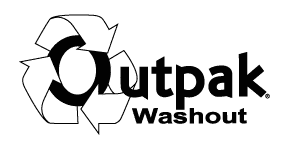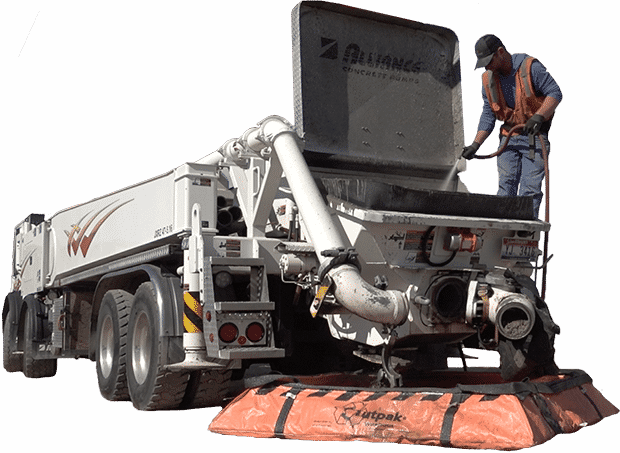Outpak Washout – Thinking Outside AND Inside the Box
As the North American construction sector continues to grow, environmental concerns spike. Concrete washout is leftover residue created from rinsing concrete truck chutes, and the washout from a construction site is full of toxic materials that should not be anywhere near groundwater sources. There are different solutions in place, but new ones are needed, especially considering growing enforcement of the federal Clean Water Act.
Outpak Washout, the originator of the portable, disposable washout, has a solution that is simple and cost-effective. Company Chief Executive Officer and Founder Bob Eason developed a box for containing concrete washout, and it is poised to make a huge impact in the green initiatives of storm water protection. We spoke with Bob about his ideas and his company.
Bob was a concrete contractor for thirty years in Boise, Idaho. In the early years, environmental regulations were not being readily enforced. But within in the last 15 years, it became mandatory to have a washout area onsite before passing a footing inspection.
“I wanted to learn more about why these regulations were necessary and found out it’s not the concrete being left on the ground, but the high PH level in the slurry water seeping into the water table.”
After this realization, Bob founded Outpak Washout, which manufactures temporary, disposable construction site washouts to be used as part of what the Environmental Protection Agency (EPA) refers to as a Stormwater Pollution Prevention Plan (SWPPP).
“Paying my employees to build a washout was not cost-effect; I needed them to set forms and pour concrete.”
He came up with the idea of a box with a bag liner in it. “I’m not an engineer, but I liked the look of it when angled. It has a thirty-degree angle which gives it more strength. And I wanted it to be easily transportable so I made the design fold flat,” says Bob. He has a patent on the origami-like folding shape of the box.
There are currently job sites that use large metal roll-offs. These are used for large commercial construction applications. Outpak Washouts are designed for smaller jobsites with less space for the washout area. “We promote washout containment at all sizes of construction sites. But our washouts are a more portable, temporary and disposable washout for smaller applications like tenant improvements or replacing a driveway in an existing subdivision.
Customers regularly ask about how to move them. Once the concrete has hardened, they can easily be picked up with a forklift or a backhoe. “We try to make them environmental all around. You can recycle them if you choose to.”
Many of the nation’s largest home builders are getting on board with Outpak’s products. “Everybody claims they are environmentally conscious, and this is an excellent way to prove to their customers that they are,” says Bob.
Over the years, Bob has listened to customer feedback and has developed different items. Outpak Washouts come in five sizes and are made of three different materials – to meet the needs of various types of projects.
“I created the All-Weather Washout for areas where there is a lot of rainy weather,” said Bob. It is a polypropylene bag with 5 to 1 rated lifting straps and has a detached rain fly available.
Other items produced by Outpak include two sizes of spill kits, which are used if a hydraulic line ruptures or if there is a radiator spill. There is a blueprint plan bag – a PVC bag with a clear front – which Bob designed for his own crews twenty years ago. It protects blueprints on a worksite from the wind and rain.
The company also carries a product called Slurry Solution, which is an organic blend of polymers that encapsulates the high PH water in the washout, creating an environmentally-friendly material ready for a landfill.
Washout water is called a silent polluter because most people do not consider the implications. Washing out onto a lawn or into a gutter will seep into the water table and can be a $10,000 fine. Dealing with it is a simple matter of educating people about solutions. Because of this, Outpak goes to many stormwater trade shows throughout the country where it meets with regulators, inspectors, EPA people, engineers, and architects.
Bob oversees the Outpak research and development efforts and is constantly coming up with new products. The paint industry is adopting the practice now, too. Painters would normally spray out in a five-gallon bucket and dispose of it somewhere. Now, there are specs calling for a paint washout on job sites for commercial work. Outpak is currently working on some new products to serve the paint industry.
Bob started Outpak from scratch, and now the company works with over 185 distributors, who have more than five hundred branches in the U.S. Outpak also exports to six other countries around the world.
Outpak only sells through distributors and not directly to end-users. Typical customers include environmental erosion control companies, concrete accessory providers, lumber yards, ready-mix companies, and pump companies.
Outpak is getting weekly calls from different parts of the country, in states that are just beginning to enforce the Clean Water Act. “Distributors and end-users are scrambling, looking for a solution, and that’s where our work with these stormwater agencies throughout the country has really paid off. We are the leaders in building this category,” says Bob.

